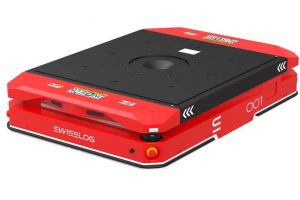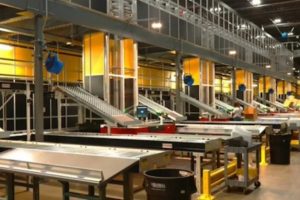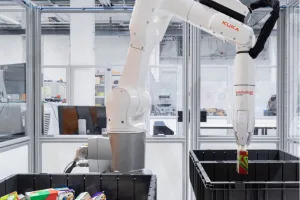Robotics and data-driven intralogistics for smart operations
The pressures and constraints of operations make it more important than ever to start applying Industry 4.0 concepts. Industry 4.0 constitutes a fourth industrial revolution and spans across a mix of powerful, data-driven technologies. For several years, Industry 4.0 has intrigued many industry professionals because of its potential to address the challenges of running operations more efficiently.
This is attained by having digital, near real-time knowledge over resources, constraints and workflows, and by applying data-driven insights to systems on the floor. Industry 4.0 spans multiple technologies, but at a high level, it means that via digitalisation we can respond to customers in an accurate, cost-efficient way.
The next step for businesses is to consider how to use Industry 4.0 building blocks such as robotics, Big Data, sensors, and Internet of Things (IoT) connectivity, and turn them into smarter, data-driven operations that combine ‘intralogistics’ processes?
Flexible, smart response
In Swisslog’s approach to Industry 4.0, software plays a key role in achieving data-driven operations that can instantly adapt to changing customer requirements, while taking out costs and being far more flexible than previous generations of automation, explains Francis Meier, managing director for Swisslog ANZ. “The need to respond very quickly to order fulfillment requirements and rapidly changing consumer demand is driving up labour costs at many facilities, which increases the need to automate,” said Mr Meier. “However, the challenge is that automation needs to be flexible to accommodate today’s pattern of smaller, more frequent orders and sudden shifts in demand. This means that automation needs to be data driven, and in sync with all resources and existing systems.”
A completely automated facility that doesn’t require any labour (i.e. a ‘lights out’ approach), has proven to be elusive, in part because past generations of robotics weren’t very flexible. Nevertheless, the new generation of collaborative and mobile robots, that are aware of their surrounding systems can now be deployed in an operational environment as they provide the flexibility and know-how required to safely work alongside humans. This new breed of intralogistics robots make use of vision-based navigation, sensors, and machine learning to allow them to sense and study their environments, make decisions, and be either mobile or easy to configure in a modular fashion. Swisslog’s solution set exemplifies this new breed of robotics that can collaborate with humans and synchronises with both enterprise- and control-level processes.
One important layer that shouldn’t be overlooked is warehouse software because it coordinates real time automation processes with enterprise management systems, including traditional warehouse management system (WMS) and enterprise resource planning (ERP) systems. For example, Swisslog’s advanced warehouse software, called SynQ, spans automation control, material flow control and warehouse management functions to handle the coordination role.
Modular software
Swisslog’s SynQ, a service-based modular software platform, provides the functionality needed to optimize warehouse operations. It embeds intelligence and synchronizes the performance of an automated warehouse. With these flexible, self-learning and data driven logistics solutions, warehouses can remain efficient even in the face of increasing customer demands.
As part of SynQ, Condition Monitoring allows users to view the current state of an intralogistics system at any time and ensures equipment works at maximum efficiency for the longest lifespan. Condition Monitoring predicts possible problems, reducing the risk of unscheduled downtime and maximizing delivery reliability.
At the opening ceremony of LogiMAT 2017, Swisslog Condition Monitoring was honoured with the “Best Product” award in the Software, Communication and IT category. Swisslog’s solution concept impressed the high-caliber jury of scientists and trade journalists thanks to its substantial contribution towards streamlining processes, saving costs and increasing productivity in intralogistics.

SynQ is compatible with robotic solutions across the entire Swisslog range, including AutoStore and CarryPick. As one of the best goods-to-person solutions available today, AutoStore has revolutionized e-commerce fulfillment and small item order picking. The scalable system can be deployed relatively quickly in almost any warehouse environment, providing dramatic improvements in space utilization and productivity compared to traditional shelf-based storage. The CarryPick solution, an automated storage and order fulfillment system, is a flexible, scalable asset for delivering high value to customers in multi-channel fulfillment operations. Users are able to choose the SynQ functionality they need, which will improve cost effectiveness, but the modular design also allows simple reaction to different customers.
Additionally, robotics from Swisslog’s parent company KUKA, as part of its AutoPiQ solution, are smaller, collaborative robots or ‘co-bots’ that can work safely alongside humans. To accomplish this, co-bots use sensors to instantly stop movement if something enters its path. The result is that companies can leverage picking robots alongside workers for intralogistics processes, using SynQ to intelligently coordinate the automation with available resources and incoming order details.
Achieve your goals
Building mixed case pallets quickly and accurately is a common challenge in DCs. In the past, robotics arms that build mixed/layered pallets were used but often tended to carry a high price tag. Today, newer, more modular approaches are possible. Under Swisslog’s ACPaQ, robotic systems for de-palletising and palletising can be paired with CycloneCarrier shuttle technology to enable a fully automated process controlled by SynQ software. The shuttle system is modular, meaning it is available in different dimensions and can be expanded to add capacity. Other technology elements that fit with the Industry 4.0 concept are Big Data and digital representation of physical processes, also known as the concept of a ‘digital shadow’ of an operation. The key with Industry 4.0 and related technologies such as Big Data is to examine how they can support intelligent decisions for specific operational goals by turning Big Data into Smart Data.
“The future for intralogistics isn’t from a single technology like robotics, or sensors, or even Big Data, but rather how these elements can be tied together with software to drive operational improvements like fulfilling orders with lower labour costs,” Mr Meier concluded. “In this continuously changing world, we believe Industry 4.0 can bring revolutionary improvements to intralogistics,” he said. “Flexible robotics and data-driven solutions are the direction we see, with the end goals being cost-competitiveness for operations and a higher level of responsiveness and product availability for end customers.”
Swisslog’s Industry 4.0 concept ensures tomorrow’s material handling processes today. Thanks to flexible, adaptive logistics solutions, warehouses can improve efficiency in the face of constantly changing customer requirements. Backed by KUKA, Swisslog is ready to lead businesses on the journey to achieving the highest intralogistics performance in a digital age.
Website: www.swisslog.com






